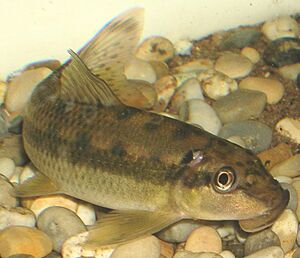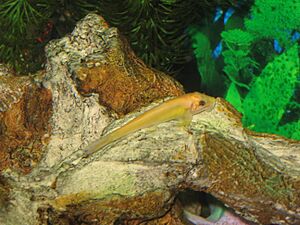Gyrinocheilus aymonieri facts for kids
Quick facts for kids Gyrinocheilus aymonieri |
|
|---|---|
 |
|
| Gyrinocheilus aymonieri | |
| Conservation status | |
| Scientific classification | |
| Synonyms | |
|
The Gyrinocheilus aymonieri is a fascinating freshwater fish. It lives in many parts of Southeast Asia. People often call it the honey sucker, sucking loach, or Chinese algae eater. This fish is important both as a local food source and for people who keep fish in aquariums.
You can find G. aymonieri in large river systems. These include the Chao Phraya basin and the Mekong basin. It lives in countries like Cambodia, Laos, Thailand, and Vietnam. This fish loves to spend its time on flat surfaces. It uses its special mouth to stick to rocks in fast-moving water.
Contents
About the Chinese Algae Eater
Where This Fish Lives
The Chinese algae eater is native to Southeast Asia. It lives in big rivers like the Chao Phraya and Mekong basins. Sometimes, it even swims into flooded fields. It likes areas with flowing water.
What It Looks Like
This fish can grow to be about 28 centimeters (11 inches) long. It has a unique mouth on its underside. This mouth works like a suction cup. It helps the fish attach itself to smooth surfaces like rocks. This way, it can stay put even in strong currents.
The wild fish can be light gray to olive green. They often have darker marks along their sides. These marks can look like a solid stripe or uneven dots. Their bellies are usually lighter in color.
How It Got Its Name
The scientific name, Gyrinocheilus aymonieri, honors a French explorer. His name was Étienne Aymonier. He lived from 1844 to 1929.
Chinese Algae Eaters in Aquariums
Many people buy G. aymonieri for their home aquariums. They are often sold as "algae eaters." This is because they love to munch on algae when they are young.
Different Colors
These fish come in many cool colors. You can find the natural wild type. There are also golden, marble, and even albino forms. Albino fish have very little or no color.
Feeding Habits in Aquariums
When they are young, these fish are great at eating algae. But as they get older, they start to want more meaty foods. If they don't get enough of the right food, they might try to eat the slime off other fish. This can make other fish sick or stressed. So, it's important to feed them well.
Reproduction in Aquariums
It is quite hard for these fish to breed in home aquariums. Sometimes, baby fish are found in tanks that have lots of plants. Scientists don't fully know what makes them lay eggs. It's also tough to tell male and female fish apart. But older males might grow small bumps on their noses. Females tend to look a bit plumper.



